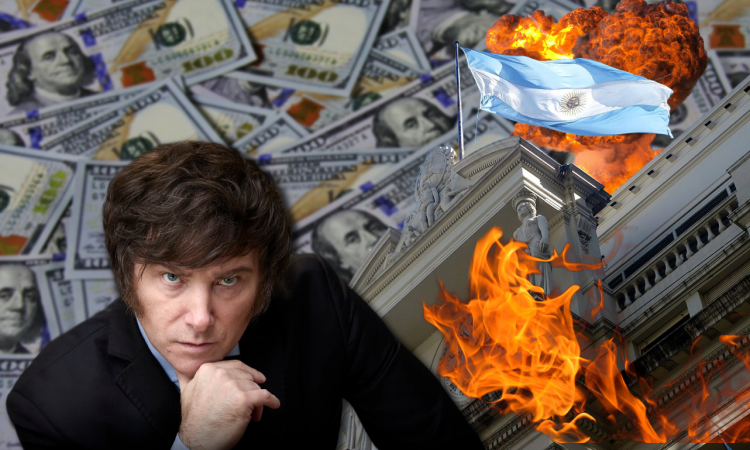Javier Milei, Argentina’s paleolibertarian presidential candidate of the Liberty Advances coalition, has pledged to shut down the Central Bank (BCRA), dollarize the economy, and end the country’s hyperinflation. Empirical evidence in other Latin American countries such as Ecuador, El Salvador, and Panama has shown that dollarization is an effective policy to rein in inflation—the gravest concern of Argentines.
Milei is leading the polls to win Argentina’s presidency in the October 22 election with 34 percent. While incumbent Peronista Economy Minister Sergio Massa is second with 29 percent, Patricia Bullrich, former security minister under President Mauricio Macri, is third with 25 percent. According to the National Electoral Chamber, a candidate needs to obtain either more than 45 percent of the total votes or 40 percent with a difference of 10 percent from the runner-up to win the presidency in the first round.
Argentines have an historic opportunity to end the BCRA’s authority over monetary policy, and they must seize the opportunity to halt instability and stealth taxation. Milei has described the institution’s reign over monetary policy as “a scam from politicians against citizens” because it has caused the country’s hyperinflation. According to Argentine economist Roberto Cachanosky, from the BCRA’s foundation in 1935 until 2018, the inflation rate amounted to 53 percent annually over the past 83 years. With his government plan, Milei will get Argentina back on track. Now destroyed by socialist policies, in the 19th century the country had the highest GDP per capita in the world.
The Crisis that Never Ends
Argentina’s inflation crisis has been repeating for the past 50 years. In 1974–1975, during the so-called “Rodrigazo” (a reference to former Peronista Economy Minister Celestino Rodrigo), the country experienced annual inflation of 777 percent. Between June 1984 and June 1985 inflation was 1,352 percent, and in 1989 it reached 4,923 percent.
In 1991, President Carlos Menem presented the Convertibility Law to Congress, which pegged the Argentine peso to the dollar, commonly known as the “one-to-one.” This law drastically reduced the country’s hyperinflation and stabilized the economy. However, in 2002, the Fernando de la Rúa administration abolished the law, which allowed bureaucrats to politicize monetary policy. Consider that in 2001 one dollar equaled one peso, but in 2023 it converts to 780 pesos on the open (blue dollar) market. Even as recently as 2016 one dollar fetched only 15 pesos.
Milei, a follower of the Austrian school of economics, is proposing a liberty-oriented revolution that includes reforms such as (1) reducing government expenditure by 15 percent of GDP, (2) privatizing state-owned companies, and (3) shutting down the BCRA so there can be competition between currencies. The latter seeks to allow citizens to use any currency of their preference. These proposals represent a 180-degree departure from Peronista patronage that has led to the inflation crisis.
Aquí el video…!!! pic.twitter.com/jjA5RICcg4
— Javier Milei (@JMilei) September 26, 2023
According to the National Statistics Institute, Argentines have savings in dollars—outside of the local financial system—of $250 billion, which is six times the BCRA reserves. This confirms that citizens already prefer the dollar over other currencies, including their peso of vanishing value. Federal politicians, through their bread-and-circus, money-printing policies, have destroyed their own currency, forcing citizens into a de facto dollarization.
Reform or Let the World Pass You By
The Argentine economy needs price stability, among other reforms, to lift investor confidence and grow, which is something the dollar can provide. Those who oppose dollarization claim that there are not enough dollars in the state to make it happen. On the other hand, Luis Espinosa Goded, economics professor at San Francisco University in Ecuador, argues that the upcoming administration can carry out a dollarization of the Argentine economy by using the BCRA’s international reserves at the free exchange rate at the time of doing it, which is equivalent to the total money supply: pesos in circulation and the BCRA’s Liquidity Bills (Leliqs).
Despite the draconian state control for purchasing dollars, citizens have carried out a progressive and spontaneous de facto dollarization. Argentines are already using the dollar for selling and purchasing real estate, cars, and appliances. Although far from perfect, the dollar is far better than the alternative, and to Argentines the dollar invokes credibility and trust.
Dollarization has worked in countries after deep economic crises. For example, in Ecuador, the Jamil Mahuad administration dollarized the economy after the 1999 economic crisis. In the process of dollarizing, the government established a time limit of nine months for citizens to change their sucres (the Ecuadorian currency at the time) for dollars.
It has also worked on relatively sound economies. The Francisco Flores administration (1999–2004) in El Salvador dollarized the economy in 2001 while being economically stable. The government’s objective was to bolster international trade, especially with the United States. In the cases of Ecuador and El Salvador, alongside that of Panama, inflation has not been a problem since dollarization.
Dollarization reduces a politician’s ability to print money and politicize monetary policy, which causes inflation. Further, trying to dedollarize—to back out in favor of another currency—has proved difficult for any politician. Former Ecuadorian socialist President Rafael Correa, despite high popularity, failed to dedollarize. The proof is in the pudding: the dollar was more popular than he was, and nine out of 10 Ecuadorians favor use of the dollar. Similarly, Salvadoran President Nayib Bukele’s attempts to give bitcoin legal-tender status have ended in embarrassment and with little interest from constituents.
Even if dollarization is not the only way to reduce inflation, Argentine politicians have shown for decades that they are irresponsible and incapable of managing their own currency. The Argentine Constitution, in Article 75, establishes that Congress must defend the currency’s value, which congressmen have more than slightly failed to accomplish. In 2023, Argentina will be the country with the third-highest inflation rate in the world, behind only Venezuela and Zimbabwe.
To end inflation and empower Argentines, dollarizing the economy is a no-brainer. However, it is not a cure-all. As long as the state fails to balance its finances—spending more than it brings in—economic problems will persist. If Milei and his team get to office, they have the task of taking a massive about-turn to get Argentina back on track.
This article reflects the views of the author and not necessarily the views of the Impunity Observer.
 Join us in our mission to foster positive relations between the United States and Latin America through independent journalism.
Join us in our mission to foster positive relations between the United States and Latin America through independent journalism.
As we improve our quality and deepen our coverage, we wish to make the Impunity Observer financially sustainable and reader-oriented. In return, we ask that you show your support in the form of subscriptions.
Non-subscribers can read up to six articles per month. Subscribe here.

